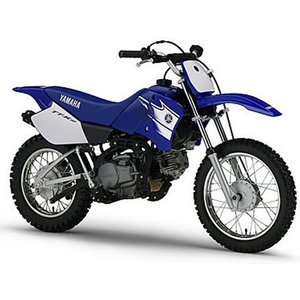Yamaha TT-R 90 (2000-2004): A Timeless Entry into the Dirt Bike World
Introduction
The Yamaha TT-R 90, produced between 2000 and 2004, remains a legendary name in the realm of entry-level dirt bikes. Designed as a gateway for young riders and beginners, this minibike blends approachability with just enough grit to ignite a passion for off-road riding. Even today, its reputation as a reliable, forgiving, and fun machine keeps it relevant in used markets and garage collections. After spending a day thrashing a well-maintained 2003 model through trails and open fields, it’s clear why this bike has earned its stripes. Whether you’re a parent looking to introduce your child to motorcycling or an adult seeking a stress-free trail companion, the TT-R 90 delivers smiles without intimidation.
Design & Ergonomics: Small Stature, Big Confidence
At first glance, the TT-R 90’s compact dimensions scream “beginner-friendly.” With a seat height of 625 mm (24.6 inches) and a dry weight of just 60 kg (132 lbs), it’s easy to maneuver for riders of all sizes. The narrow 605 mm (23.8-inch) width and short 1,525 mm (60-inch) length make it agile, while the low center of gravity inspires confidence when tackling uneven terrain. Yamaha’s signature blue plastics (the only color option) give it a classic, sporty look that hasn’t aged a day.
The bike’s 172 mm (6.8 inches) of ground clearance (later models) allows it to crawl over logs and ruts without scraping, though it’s best suited for light trails rather than hardcore motocross. The steel frame feels sturdy, and the overall build quality reflects Yamaha’s knack for durability—a key trait for a bike likely to endure a few drops as riders learn the ropes.
Engine & Performance: Gentle Power for Learning Curves
The heart of the TT-R 90 is its 89 cc (5.43 cubic inches) liquid-cooled, four-stroke single-cylinder engine. With 5.5–5.6 HP (4.0–4.1 kW) and 6.1 Nm (4.5 lb-ft) of torque, this isn’t a bike for speed demons. Instead, it’s a masterclass in controllable power delivery. The engine’s broad torque curve—peaking between 4,000–6,500 RPM—pulls smoothly from low revs, making it forgiving for riders still mastering clutch control.
The 3-speed manual transmission (with a manual clutch!) is a standout feature. Unlike automatic minibikes, the TT-R 90 teaches fundamental skills like gear shifting and throttle modulation. The clutch is light enough for small hands, and the gearbox slots cleanly into place. On tight trails, second gear becomes your best friend, while first and third handle steep climbs and straightaways, respectively.
Liquid cooling ensures consistent performance even during prolonged rides—a rare feature in this class. You won’t overheat it unless you’re trying to win a desert race, which this bike wasn’t built for anyway.
Handling & Suspension: Where the TT-R 90 Shines
The TT-R 90’s handling is its crowning achievement. The 1,040 mm (40.9-inch) wheelbase strikes a balance between stability and agility, letting you weave through trees or straighten out on gravel paths without drama. The telescopic front fork offers 110 mm (4.3 inches) of travel, while the rear monocross suspension provides 95 mm (3.7 inches). These numbers won’t rival full-sized dirt bikes, but they’re ample for absorbing small jumps and trail chatter.
Drum brakes front and rear are period-appropriate and adequate for the bike’s speed. They require a firm squeeze, but this teaches riders to plan ahead—a valuable skill. The 17-inch front and 14-inch rear wheels (with chunky knobby tires) grip loose dirt surprisingly well, though upgrading to modern rubber can enhance traction.
Competition: How the TT-R 90 Stacks Up
The early 2000s minibike segment was crowded, but the TT-R 90 held its own against rivals like:
Honda XR80
- Pros: Slightly more suspension travel, air-cooled simplicity.
- Cons: No liquid cooling, heavier at 68 kg (150 lbs).
- Verdict: The TT-R 90’s lighter weight and cooling system make it better for longer rides.
Kawasaki KLX110 (Introduced in 2003)
- Pros: Larger 112 cc engine, auto-clutch option.
- Cons: Heavier, less beginner-friendly clutch control.
- Verdict: The KLX110 suits older kids, but the TT-R 90 is gentler for true novices.
Suzuki DR-Z70
- Pros: Ultra-lightweight (54 kg / 119 lbs), auto transmission.
- Cons: Underpowered 69 cc engine, fewer growth opportunities.
- Verdict: The TT-R 90’s manual gearbox builds better riding fundamentals.
Maintenance: Keeping Your TT-R 90 Alive
Yamaha’s TT-R 90 is famously low-maintenance, but a little care goes a long way:
- Cooling System: Check coolant levels annually and flush every two years.
- Oil Changes: Replace every 20–30 hours of riding. Use 10W-40 motorcycle oil.
- Air Filter: Clean after dusty rides—MOTOPARTS.store stocks reusable foam filters.
- Chain Care: Lubricate regularly and adjust tension to prevent wear.
- Brakes: Drum shoes last ages but inspect for glazing. Upgrade to sintered pads for sharper stopping.
Recommended Upgrades from MOTOPARTS.store
- High-Flow Air Filter: Unlock a touch more mid-range punch.
- Aftermarket Exhaust: Save weight and add a throatier sound (keep the dB legal!).
- Handlebar Risers: Improve comfort for taller riders.
- Skid Plate: Protect the engine during rocky adventures.
Final Thoughts: Why the TT-R 90 Still Matters
The Yamaha TT-R 90 isn’t about breaking records—it’s about breaking barriers. It’s the bike that turns nervous first-timers into confident riders, one gentle power slide at a time. While modern minibikes have flashier tech, the 2000–2004 TT-R 90’s simplicity, durability, and timeless design keep it in demand. Whether you’re reviving a barn find or customizing a trail warrior, MOTOPARTS.store has the gear to keep your Yamaha running—and grinning—for years to come.



















